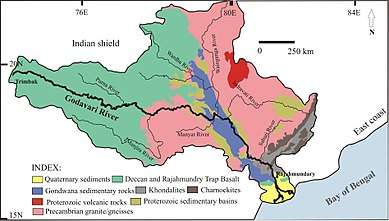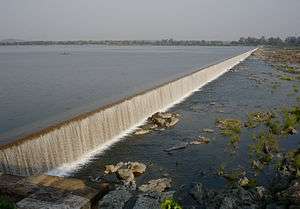Bilaspur–Nagpur section
The Bilaspur–Nagpur section is part of the Howrah-Nagpur-Mumbai line and connects Bilaspur in the Indian state of Chhattisgarh and Nagpur in Maharashtra. Part of one of the major trunk lines in the country, it passes through a forested plateau region interspersed with fertile valleys.
| Bilaspur–Nagpur section | |
|---|---|
| Overview | |
| System | Main lines and some branch lines which are electrified & Some branch lines are in unelectrified. |
| Status | Operational |
| Locale | Chhattisgarh, Maharashtra, Madhya Pradesh |
| Termini | Bilaspur Nagpur |
| Services | Howrah-Nagpur-Mumbai line |
| Operation | |
| Opened | 1891 |
| Owner | Indian Railway |
| Operator(s) | South East Central Railway |
| Technical | |
| Track length | Main line: 414 km (257 mi) Branch lines: kendri-Dhamtari NG: 68 km (42 mi) Durg-Dalli Rajhara: 87 km (54 mi) Gondia-Balaghat-Katangi: 88 km (55 mi) Tumsar Road-Tirodi: 48 km (30 mi) Gondia-Nagbhir-Balharshah: 252 km (157 mi) Nagpur-Nagbhir NG: 110 km (68 mi) Kanhan-Ramtek: 23 km (14 mi) Nagpur-Chhindwara NG: 110 km (68 mi) Chhindwara-Amla: 115 km (71 mi) |
| Number of tracks | Main line: 3 between Bilaspur to rajnandgaon 2 rajnandgaon to Nagpur |
| Track gauge | Broad gauge 1,676 mm (5 ft 6 in) with some branch lines: Narrow gauge 2 ft 6 in (762 mm) |
| Operating speed | Main line: up to 160 km/hr |
| Bilaspur–Nagpur section | |||||||||||||||||||||||||||||||||||||||||||||||||||||||||||||||||||||||||||||||||||||||||||||||||||||||||||||||||||||||||||||||||||||||||||||||||||||||||||||||||||||||||||||||||||||||||||||||||||||||||||||||||||||||||||||||||||||||||||||||||||||||||||||||||||||||||||||||||||||||||||||||||||||||||||||||||||||||||||||||||||||||||||||||||||||||||||||||||||||||||||||||||||||||||||||||||||||||||||||||||||||||||||||||||||||||||||||||||||||||||||||||||||||||||||||||||||||||||||||||||||||||||||||||||||||||||||||||||||||||||||||||||||||||||||||||||||||||||||||||||||||||||||||||||||||||||||||||||||||||||||||||||||||||||||||||||||||||||||||||||||||||||||||||||||||||||||||||||||||||||||||||||||||||||||||||||||||||||||||||||||||||||||||||||||||||||||||||||||||||||||||||||||||||||||||||||||||||||||||||||||||||||||||||||||||||||||||||||||||||||||||||||||||||||||||||||||||||||||||||||||||||||||||||||||||||||||||||||||||||||||||||||||||||||||||||||||||||||||||||||||||||||||||||||||||||||||||||||||||||
|---|---|---|---|---|---|---|---|---|---|---|---|---|---|---|---|---|---|---|---|---|---|---|---|---|---|---|---|---|---|---|---|---|---|---|---|---|---|---|---|---|---|---|---|---|---|---|---|---|---|---|---|---|---|---|---|---|---|---|---|---|---|---|---|---|---|---|---|---|---|---|---|---|---|---|---|---|---|---|---|---|---|---|---|---|---|---|---|---|---|---|---|---|---|---|---|---|---|---|---|---|---|---|---|---|---|---|---|---|---|---|---|---|---|---|---|---|---|---|---|---|---|---|---|---|---|---|---|---|---|---|---|---|---|---|---|---|---|---|---|---|---|---|---|---|---|---|---|---|---|---|---|---|---|---|---|---|---|---|---|---|---|---|---|---|---|---|---|---|---|---|---|---|---|---|---|---|---|---|---|---|---|---|---|---|---|---|---|---|---|---|---|---|---|---|---|---|---|---|---|---|---|---|---|---|---|---|---|---|---|---|---|---|---|---|---|---|---|---|---|---|---|---|---|---|---|---|---|---|---|---|---|---|---|---|---|---|---|---|---|---|---|---|---|---|---|---|---|---|---|---|---|---|---|---|---|---|---|---|---|---|---|---|---|---|---|---|---|---|---|---|---|---|---|---|---|---|---|---|---|---|---|---|---|---|---|---|---|---|---|---|---|---|---|---|---|---|---|---|---|---|---|---|---|---|---|---|---|---|---|---|---|---|---|---|---|---|---|---|---|---|---|---|---|---|---|---|---|---|---|---|---|---|---|---|---|---|---|---|---|---|---|---|---|---|---|---|---|---|---|---|---|---|---|---|---|---|---|---|---|---|---|---|---|---|---|---|---|---|---|---|---|---|---|---|---|---|---|---|---|---|---|---|---|---|---|---|---|---|---|---|---|---|---|---|---|---|---|---|---|---|---|---|---|---|---|---|---|---|---|---|---|---|---|---|---|---|---|---|---|---|---|---|---|---|---|---|---|---|---|---|---|---|---|---|---|---|---|---|---|---|---|---|---|---|---|---|---|---|---|---|---|---|---|---|---|---|---|---|---|---|---|---|---|---|---|---|---|---|---|---|---|---|---|---|---|---|---|---|---|---|---|---|---|---|---|---|---|---|---|---|---|---|---|---|---|---|---|---|---|---|---|---|---|---|---|---|---|---|---|---|---|---|---|---|---|---|---|---|---|---|---|---|---|---|---|---|---|---|---|---|---|---|---|---|---|---|---|---|---|---|---|---|---|---|---|---|---|---|---|---|---|---|---|---|---|---|---|---|---|---|---|---|---|---|---|---|---|---|---|---|---|---|---|---|---|---|---|---|---|---|---|---|---|---|---|---|---|---|---|---|---|---|---|---|---|---|---|---|---|---|---|---|---|---|---|---|---|---|---|---|---|---|---|---|---|---|---|---|---|---|---|---|---|---|---|---|---|---|---|---|---|---|---|---|---|---|---|---|---|---|---|---|---|---|---|---|---|---|---|---|---|---|---|---|---|---|---|---|---|---|---|---|---|---|---|---|---|---|---|---|---|---|---|---|---|---|---|---|---|---|---|---|---|---|---|---|---|---|---|---|---|---|---|---|---|---|---|---|---|---|---|---|---|---|---|---|---|---|---|---|---|---|---|---|---|---|---|---|---|---|---|---|---|---|---|---|---|---|---|---|---|---|---|---|---|---|---|---|---|---|---|---|---|---|---|---|---|---|---|---|---|---|---|---|---|---|---|---|---|---|---|---|---|---|---|---|---|---|---|---|---|---|---|---|---|---|---|---|---|---|---|---|---|---|---|---|---|---|---|---|---|---|---|---|---|---|---|---|---|---|---|---|---|---|---|---|---|---|---|---|---|---|---|---|---|---|---|---|---|---|---|---|---|---|---|---|---|---|---|---|---|---|---|---|---|---|---|---|---|---|---|---|---|---|---|---|---|---|---|---|---|---|---|---|---|---|---|---|---|---|---|---|---|---|---|---|---|---|---|---|---|---|---|---|---|---|---|---|---|---|---|---|---|---|---|---|---|---|---|---|---|---|---|---|---|---|---|---|---|---|---|---|---|---|---|---|---|---|---|---|---|---|---|---|---|---|---|---|---|---|---|---|---|---|---|---|---|---|---|---|---|---|---|---|---|---|---|---|---|---|---|---|---|---|---|---|---|---|---|---|---|---|---|---|---|---|---|---|---|---|---|---|---|---|---|---|---|---|---|---|---|---|---|---|---|---|---|---|---|---|---|---|---|---|---|---|---|---|---|---|---|---|---|---|---|---|---|---|---|
Source:Google maps, Itwari Tatanagar Passenger, | |||||||||||||||||||||||||||||||||||||||||||||||||||||||||||||||||||||||||||||||||||||||||||||||||||||||||||||||||||||||||||||||||||||||||||||||||||||||||||||||||||||||||||||||||||||||||||||||||||||||||||||||||||||||||||||||||||||||||||||||||||||||||||||||||||||||||||||||||||||||||||||||||||||||||||||||||||||||||||||||||||||||||||||||||||||||||||||||||||||||||||||||||||||||||||||||||||||||||||||||||||||||||||||||||||||||||||||||||||||||||||||||||||||||||||||||||||||||||||||||||||||||||||||||||||||||||||||||||||||||||||||||||||||||||||||||||||||||||||||||||||||||||||||||||||||||||||||||||||||||||||||||||||||||||||||||||||||||||||||||||||||||||||||||||||||||||||||||||||||||||||||||||||||||||||||||||||||||||||||||||||||||||||||||||||||||||||||||||||||||||||||||||||||||||||||||||||||||||||||||||||||||||||||||||||||||||||||||||||||||||||||||||||||||||||||||||||||||||||||||||||||||||||||||||||||||||||||||||||||||||||||||||||||||||||||||||||||||||||||||||||||||||||||||||||||||||||||||||||||||
History
The first train in India travelled from Mumbai to Thane on 16 April 1853. By May, 1854, Great Indian Peninsula Railway's Bombay-Thane line was extended to Kalyan. Bhusawal station was set up in 1860 and in 1867 the GIPR branch line was extended to Nagpur.[1] The Nagpur Chhattisgarh Railway started construction of the 240 km (149 mi) metre gauge (soon converted to broad gauge) Nagpur-Rajnandgaon section in 1878, after surveys were started in 1871. The Nagpur-Tumsar Road section was opened in April 1880 and the Tumsar Road-Rajnandgaon section in December 1880.[2]
The Howrah–Allahabad–Mumbai line, a joint effort of Great Indian Peninsula Railway and East Indian Railway Company came up in 1870.[3] The Bengal Nagpur Railway was formed in 1887 for the purpose of upgrading the Nagpur Chhattisgarh Railway and then extending it via Bilaspur to Asansol, in order to develop a shorter Howrah-Mumbai route than the one via Allahabad.[4] The Bengal Nagpur Railway main line from Nagpur to Asansol, on the Howrah-Delhi main line, was opened for goods traffic on 1 February 1891.[5]
A narrow gauge branch line was constructed from Raipur to Dhamtari, and from Abhanpur another branch line goes to Rajim. It was opened in 1900.[6] The Gondia-Nagbhir-Nagpur line was opened for traffic in 1908. The Nagbhir-Rajoli line was opened in 1913 and extended up to Chanda. The Bhilai-Dalli Rajhara line mainly for iron ore transportation was opened in 1958. Bhilai Steel Plant was opened in 1959.[5]
The Bengal Nagpur Railway was nationalized in 1944.[5]Eastern Railway was formed on 14 April 1952 with the portion of East Indian Railway Company east of Mughalsarai and the Bengal Nagpur Railway.[7] In 1955, South Eastern Railway was carved out of Eastern Railway. It comprised lines mostly operated by BNR earlier.[7][8] Amongst the new zones started in April 2003 were East Coast Railway and South East Central Railway. Both these railways were carved out of South Eastern Railway.[7]
Gauge conversion
Work for conversion to broad gauge of the 240 km (149 mi) narrow gauge Gondia-Chanda Fort line started in December 1992, Gondia-Wadsa section was inaugurated on 25 September 1994. Wadsa-Nagbhir section was opened on 20 February 1997, Nagbhir-Chanda Fort section was opened on 13 January 1999 and the Chanda Fort-Ballarshah section was operated from 2 July 1999.[9]
The Gondia-Balaghat broad gauge section was opened for traffic on 6 September 2005.[9] The Balaghat-Katangi section was converted to broad gauge in 2010.[10][9]
The gauge conversions are under process for 147 km (91 mi) long Nagpur-Chhindwara section, the 110 km (68 mi) long Jabalpur-Nainpur section, the 180 km (112 mi) long Chhindwara-Nainpur-Mandla section, the Nainpur-Balaghat section and 110 km (68 mi) long Nagpur-Nagbhir section.[11][12]
Electrification
The entire main line is electrified. The Bilaspur-Bhilai and Bhilai-Durg sections were electrified in 1970-71, Durg-Paniajob section in 1989-90. The Paniajob-Gondia and Gondia-Bhandara Road sections in 1990-91, Bhandara Road-Tharsa and Tharsa-Nagpur sections in 1991-92.[13] The Amla-Chhindwara section was electrified in 2017[14] and Balharshah-Chanda Fort-Gondia section was electrified in 2018. Other lines will be electrified once converted to broad gauge.
Speed limits
The entire Howrah-Nagpur-Mumbai line is classified as a "Group A" line which can take speeds up to 160 km/hr.[15]
Passenger movement
Bilaspur, Raipur, Durg and Nagpur on this line are amongst the top hundred booking stations of Indian Railway. About 1 to 1.2 million passengers travel from here. [16]
Narrow gauge rail museum
A Narrow Gauge Rail Museum was inaugurated at Nagpur on 14 December 2002. It was accorded the status at par with National Rail Museum, New Delhi.[9]
References
- Chronology of railways in India, Part 2 (1832 - 1865). "IR History: Early Days – I". Retrieved 20 November 2012.
- "Nagpur Division" (PDF). Retrieved 20 November 2012.
- "IR History: Early Days – II". Chronology of railways in India, Part 2 (1870 - 1899). Retrieved 10 November 2012.
- "Number 1 Down Mail". Railways of the Raj. Retrieved 10 November 2012.
- "Major Events in the Formation of S.E. Railway". South Eastern Railway. Archived from the original on 1 April 2013. Retrieved 10 November 2012.
- "Raipur District". IRFCA. Retrieved 25 December 2012.
- "Geography – Railway Zones". IRFCA. Retrieved 21 November 2012.
- "IR History: Part - IV (1947 - 1970)". IRFCA. Retrieved 21 November 2012.
- "Nagpur Division" (PDF). South East Central Railway. Retrieved 10 November 2012.
- "Balaghat-Jabalpur protest march to demand rly line". The Times of India, 17 January 2011. Retrieved 10 November 2012.
- "Funds crunch hits gauge conversion work". The Times of india, 27 April 2012. Retrieved 25 December 2012.
- "What is new in the Railway Budget 2012-13". The Times of India, 14 March 2012. Retrieved 10 November 2012.
- "History of Electrification". IRFCA. Retrieved 10 November 2012.
- https://twitter.com/central_railway/status/937269672046575616?lang=en
- "Chapter II – The Maintenance of Permanent Way". Archived from the original on 3 December 2013. Retrieved 2012-11-10.
- "Indian Railways Passenger Reservation Enquiry". Availability in trains for Top 100 Booking Stations of Indian Railways. IRFCA. Archived from the original on 10 May 2014. Retrieved 2012-11-21.



